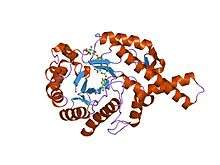Glycoside hydrolase family 56
| Hyaluronidase | |||||||||
|---|---|---|---|---|---|---|---|---|---|
 crystal structure of bee venom hyaluronidase in complex with hyaluronic acid tetramer | |||||||||
| Identifiers | |||||||||
| Symbol | Glyco_hydro_56 | ||||||||
| Pfam | PF01630 | ||||||||
| Pfam clan | CL0058 | ||||||||
| InterPro | IPR018155 | ||||||||
| SCOP | 1fcv | ||||||||
| SUPERFAMILY | 1fcv | ||||||||
| OPM superfamily | 125 | ||||||||
| OPM protein | 1fcq | ||||||||
| CAZy | GH56 | ||||||||
| |||||||||
In molecular biology, glycoside hydrolase family 56 is a family of glycoside hydrolases.
Glycoside hydrolases EC 3.2.1. are a widespread group of enzymes that hydrolyse the glycosidic bond between two or more carbohydrates, or between a carbohydrate and a non-carbohydrate moiety. A classification system for glycoside hydrolases, based on sequence similarity, has led to the definition of >100 different families.[1][2][3] This classification is available on the CAZy(http://www.cazy.org/GH1.html) web site,[4] and also discussed at CAZypedia, an online encyclopedia of carbohydrate active enzymes.[5]
Glycoside hydrolase family 56 CAZY GH_56 includes enzymes with hyaluronidase EC 3.2.1.35 activity. The venom of Apis mellifera (Honeybee) contains several biologically-active peptides and two enzymes, one of which is a hyaluronidase.[6] The amino acid sequence of bee venom hyaluronidase contains 349 amino acids, and includes four cysteines and a number of potential glycosylation sites.[6] The sequence shows a high degree of similarity to PH-20, a membrane protein of mammalian sperm involved in sperm-egg adhesion, supporting the view that hyaluronidases play a role in fertilisation.[6]
PH-20 is required for sperm adhesion to the egg zona pellucida; it is located on both the sperm plasma membrane and acrosomal membrane.[7] The amino acid sequence of the mature protein contains 468 amino acids, and includes six potential N-linked glycosylation sites and twelve cysteines, eight of which are tightly clustered near the C-terminus.[7]
References
- ↑ Henrissat B, Callebaut I, Mornon JP, Fabrega S, Lehn P, Davies G (1995). "Conserved catalytic machinery and the prediction of a common fold for several families of glycosyl hydrolases". Proc. Natl. Acad. Sci. U.S.A. 92 (15): 7090–7094. doi:10.1073/pnas.92.15.7090. PMC 41477
 . PMID 7624375.
. PMID 7624375. - ↑ Henrissat B, Davies G (1995). "Structures and mechanisms of glycosyl hydrolases". Structure. 3 (9): 853–859. doi:10.1016/S0969-2126(01)00220-9. PMID 8535779.
- ↑ Bairoch, A. "Classification of glycosyl hydrolase families and index of glycosyl hydrolase entries in SWISS-PROT". 1999.
- ↑ Henrissat, B. and Coutinho P.M. "Carbohydrate-Active Enzymes server". 1999.
- ↑ CAZypedia, an online encyclopedia of carbohydrate-active enzymes.
- 1 2 3 Gmachl M, Kreil G (1993). "Bee venom hyaluronidase is homologous to a membrane protein of mammalian sperm". Proc. Natl. Acad. Sci. U.S.A. 90 (8): 3569–3573. doi:10.1073/pnas.90.8.3569. PMC 46342
 . PMID 7682712.
. PMID 7682712. - 1 2 Lathrop WF, Carmichael EP, Myles DG, Primakoff P (1990). "cDNA cloning reveals the molecular structure of a sperm surface protein, PH-20, involved in sperm-egg adhesion and the wide distribution of its gene among mammals". J. Cell Biol. 111 (6): 2939–2949. doi:10.1083/jcb.111.6.2939. PMC 2116349
 . PMID 2269661.
. PMID 2269661.
This article incorporates text from the public domain Pfam and InterPro IPR018155